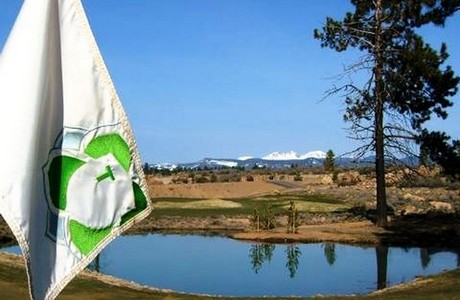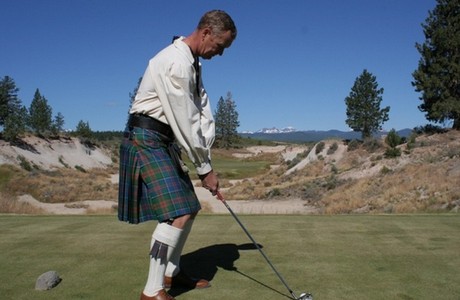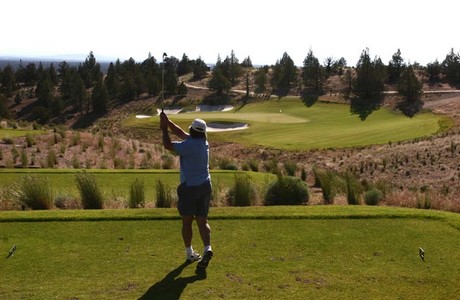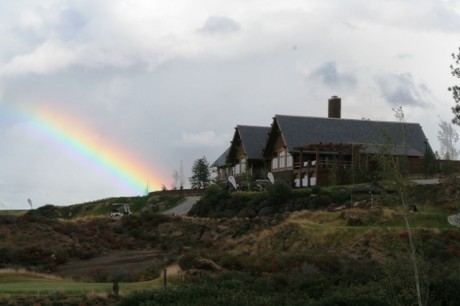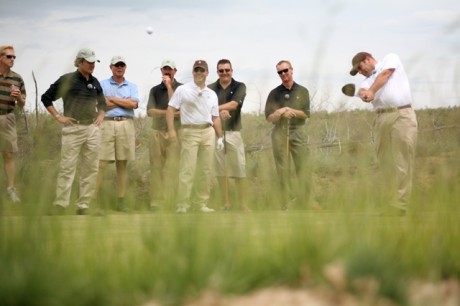A great review on the course at Tetherow by Jeff Wallach in Courses and Travel; this one is only for golfers.
The Guys From Broken Top Don’t Like It
I recently played Kidd’s Tetherow Golf Club, in Central Oregon. The course has been open for two years and I can honestly say that in that time I have never really heard anyone ever say a nice thing about it– other than how beautiful it is, which is really only one minor factor that people should consider in judging a golf course. Many of the folks I spoke to said they were glad to have played it but would never go back. An exercise in frustration. Totally out of control. Others were angrier and less kind.
Given my own tendency to hate a fair amount of modern design work that costs thousands of times what turn-of-the-century architects spent to build much better courses, I was prepared to hate Tetherow, and almost looked forward to writing a scathing review– in part because I’d loved Kidd’s original course so much and was so disappointed by what I saw in Scotland.
I Burnt My Tongue
When you arrive at Tetherow your fore-caddie greets you shortly after you check in at the pro shop desk. Ours, Aaron– who was among the best young caddies I’ve had anywhere in the world– warned us that the speed of the practice green where we were banging a few putts around was entirely different from that of the actual greens, which did nothing to improve my mood. What possible sense could that make when the entire purpose of a practice green was to give a decent putter a chance to gauge how putts might roll all day? It was an overcast morning, too cool for August, and I’d burnt my tongue on hot coffee on the way to the course. I was hunkering down for a tough day.
The first two holes did not improve my outlook. The opening tee shot requires a carry over waste areas and rough to a fairway canted in such a way that you can only see the green from the right side of it (or with a huge drive, something I don’t have)– and the last thing you want to do is hit your approach at the pin from any angle other than dead on because the green is deep but exceedingly narrow and framed by bunkers. This is a theme that repeats itself at Tetherow– don’t aim at the pins, or even the centers of the greens–until you either get it, or begin cursing the architect in frustration (but that is your problem, not his). For despite it’s location amid snow-capped mountains in central Oregon, Tetherow is a links course in spirit and pedigree, and should be played using the territory to your advantage. Why it took me so long to figure this out I cannot say.
The third hole is a visually arresting par three that ramps up the excitement. Problems arise, though, if you aim for the center of the green or anything left of there because the slope of the putting surface will trampoline such shots into a water hazard. And here lies the maddening ingenuity of the golf course: on this hole, hitting at the center of the green just isn’t the right shot. Hitting to the forgiving right side, with a slight draw, is what Kidd designed this for. And many golfers who think they’ve hit a brilliant shot to the center will be outraged to see their tee ball end with a trickle and splash. But the fact is, they haven’t hit a brilliant shot– at least by any measure intended by the architect, who is really the decider here.
Adopting Skills to Local Conditions
Let’s remember that golf, ultimately, is really about adopting your own skills to local conditions and customs, and that is what Kidd demands at Tetherow. If you’re playing on a windy course, hit the ball low. If the greens are all front-bunkered and designed with false fronts, hit it high. If the putting surfaces are flat and shaggy, putt the ball hard, and if they are fast and undulating, take more care.
On that third hole, beginning to pay attention to Aaron, our fore-caddie, I also began to understand what the architect was up to, though I still asked: is it a bad hole if a shot hit to the middle of a green winds up in a hazard? And does this change if you KNOW that’s how it’s been designed? Like a lot of players, I was distracted by the aesthetics of this gorgeously crafted layout from understanding the specific challenge Kidd had laid out– another hallmark of very good design, not bad. Though I walked away from number three furiously shaking my head.
The fourth hole actually has the opposite strategy of some of the earlier holes in that it is visually intimidating but not that difficult– this l-o-n-g par four of 481 yards from the tips features a lot of room in front of the green that you can’t see on the approach. As Kidd himself says in a video describing how to play Tetherow, “anything at the pin is a sucker, and I’ve got you.” Approaches actually need to be hit short and run up, or to the back of the green so they’ll feed back down toward most pin positions. Still, I felt this particular green had one too many features– and, in fact, Kidd has been back to the course since it opened to soften some of the more penal aspects. It’s as if, in some cases, too much design cubism renders the figure in the painting unrecognizable. And in some instances, you can’t even tell it’s a figure. Which is exactly what art is all about: testing boundaries. It just doesn’t always make for playable golf holes.
Number six offers a couple of good choices off the tee to right and left fairways– it’s a great par four with a crazy green on which you could be further away from the hole after hitting your first putt. Number seven, the longest par three at Tetherow, provides a few secret backstops that will cooperate in directing the ball toward the desired final resting place once you understand how you’re intended to play the hole.
“It’s Unbelievably Good”
By number eight my notes in the yardage book say:’ Once you see what he’s doing it’s unbelievably good.” The hole is framed by giant Ponderosa pines. Number nine suggests that a fairway wood off the tee may be appropriate– as is giving up on the idea of reaching the green in two, though it’s under 500 yards from most tees. The green, surrounded by rock outcroppings, is sublime.
Number ten encourages a heroic drive to a green just barely over 300 yards away from the back tees, but gives lesser players a chance to be smart (which they won’t) and hit a mid-iron followed by a wedge, certainly a better formula for birdie that few will decipher given the temptations to try to hit a shot you’re probably not even capable of. At the eleventh, Tetherow drops into the trees and the terrain grows rockier and even more interesting with tons of swales and collection areas and fescue-whiskered bunkers.
Seventeen is the hole you’ve seen in a hundred golf magazine photos– and it is everything a golf hole can be: pure fun, and also fair and gorgeous. The hole routes through a pumice quarry to the smallest green Kidd has ever built– about half the size of most of the other greens at Tetherow. His intention was for players to overclub here and knock it into the backboard behind the cupping areas so that the shot would trickle back toward the pin. The golf course finishes with a 588-yard downwind par five that’s as daunting as the finish at Kapalua, yet eminently par-able. And you can see the entire hole unfurling from tee toward clubhouse.
“Forget Your Score . . . Bet With Your Buddies”
Given its physical and psychological difficulty, Tetherow makes for a great match play course, which is also how it was meant to be played. Forget your score, bet with your buddies, and even if you don’t understand why, enjoy this terrific modern masterpiece for what it is. Don’t even delve into the realm of what it’s not, because you’ll miss the entire point of Kidd’s iconoclastic and artistic work. For me, Tetherow was the most fun I ever had while barely breaking 100, and I’d go back tomorrow.
